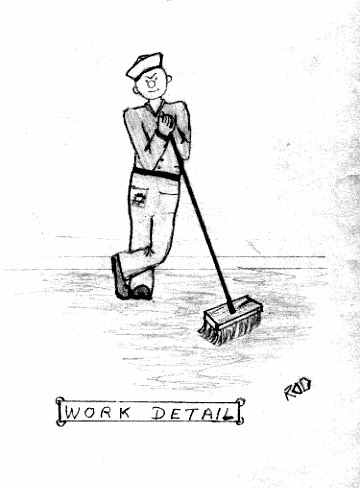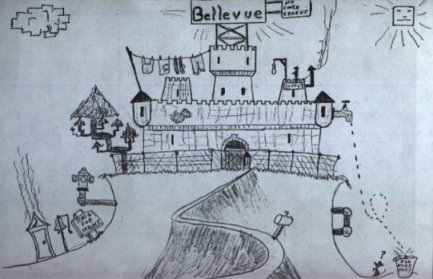Badge worn by Bob Day
at NRL during World War 2
In 1942 I had started attending U.C.L.A and learned that
the
Navy needed experienced people for a variety of jobs.
They had a
program whereby they gave ratings those who either had
experience or passed some tests.
Notably among those accepted were men from the construction
trades who made up the construction Batallions. (CBs)
I took some tests and was told that I would be accepted
as a
Second Class Radio Technician (RT2c) and I would be sent
to
some schools for specialized training.
After Boot Camp, I was sent to Treasure Island in the
San
Francisco Bay for some very basic stuff.

Next I went to the University of Houston and finally to
the Radio
Materiel School (RMS) at Bellevue in Washington D. C.
For those of you who might not know, the school was located
on
the grounds of the Naval Research Laboratory.
Like most Military schools, the discipline at the Radio
Materiel
School was strict.
The following cartoon shows my impression of the school
at the
time.

RMS also known as Bellevue
Copyright R. C. Day 5/5/99
Upon graduation from RMS I was assigned to the Combined
Research Group and worked on building engineering models
of
what was known then as the SPX2 Shipboard transponder.
After the war, I got married; worked in oil exploration
for five
years; and then spent the rest of my career working for
General
Dynamics.
ABOUT THE COMBINED RESEARCH GROUP
The Combined Research Group was a cooperative project
formed during World War 2 by the U. S. Navy, U. S. Army,
U. S. Marine Corps, and Canadian and British Militiary
services.
Hence the name "Combined Research Group" (CRG). Both
military and civilian personnel worked in the group.
It was a little known secret project at the time.
Its purpose was to develop a new Identification Friend
or Foe
system for the co-operating armed services.
The Mark 3 IFF system that was in use during World War
2 had
been compromised by the Germans and could only remain
useful
by changing the code settings frequently, almost on an
hourly
basis.
Woe be unto he who would forget to change his code settings
at
the appropriate time.
Typically that time would be when planes were returning
from a
raid over enemy territory.
The Mark 4 IFF system had apparently been even less useful.
So,
the armed services formed the Combined Research Group
to
develop a more secure and reliable IFF system. That system
was
dubbed Mark 5.
ABOUT IDENTIFICATION FRIEND OR FOE (IFF)
An IFF system works in conjunction with search radars.
It
consists of an Interogator, which sends out a coded signal
to a
ship or an aircraft, and a Transponder on the target
ship or aircraft
that sends back a coded reply.
If the correct reply is received by the interogator, the
target is
declared as a "friend". If no reply is received or the
reply is
incorrect, the target is declared as a "foe" or "unknown.
Depending upon other factors the target may be attacked
by the
defending force.
The lives of people depend upon a relable IFF system that
can not
be spoofed or disrupted by the enemy.
The Mark 5 system was quite advanced technologically for
its time
and is the basis for our air traffic control system today.
Eventually the system was deployed as the Mark 10 system.
The IFF systems in use today are even more sophisitcated
and use
encryption techniques to code the signals.
PURPOSE OF THIS WEB PAGE
World War 2 and our work in the Combined Research Group
was an important time in our lives. The training and
experience that
we had influenced the rest of our lives.
In 1990 I tried to contact my co-workers at CRG with the
intent
of having some sort of reunion such as those held by
people who
served on ships, etc.
I have used the term "co-workers" because the personnel
at CRG
included civilians as well as service personnel.
I had advertised in the American Legion Magazine with
only
minimal results.
Unfortunately, the name "Combined Research Group" is not
as
easily recognized by people as compared to a ship name
such as
the USS Missouri and was probably overlooked by most
people
who read the ad.
Now, we have the internet that reaches out to people all
over the
world and I an hoping by use of this medium to contact
people or
their families.
Remember, some of the personnel were British and Canadian
as
well as Americans. Who knows, I might contact some of
them
through the internet.
I think it will be interesting to many of us to find out
how others
have fared since the end of WW2.
I know that some of the people have passed-on, but I would
still
like to hear from their families or friends.
As I hear from people, I intend to publish an informal
news letter
with contacts or any information that you would like
to pass on to
others. It will be on an irregular basis as time, money,
and
information allow. There is no profit in it for me.
I just think it will be interesting to find out what
has happened to those of us who worked together at that time.
Who
We Are How to Join Members
Page HomePage Index
Navy News












 View
Our Ship's Log
View
Our Ship's Log












 View
Our Ship's Log
View
Our Ship's Log